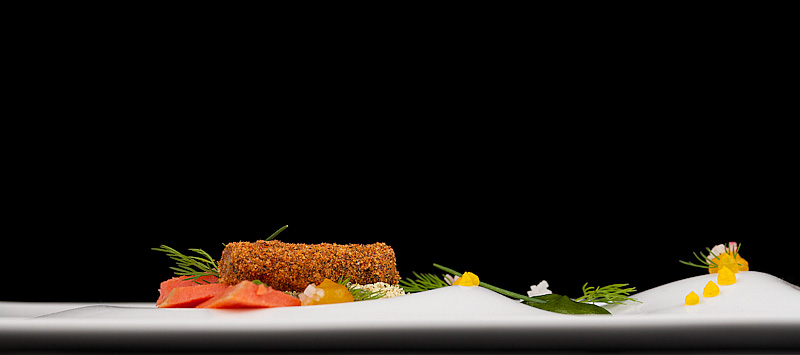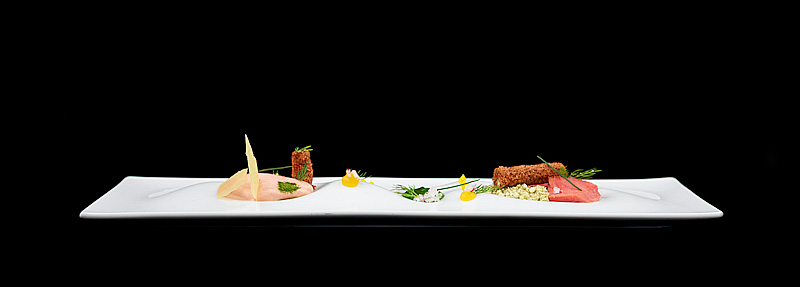
Smoked salmon mousse, lemon-saffron pudding, herb powder, flakes of smoked salmon filet, garlic chips, logs of salsify rolled in olive oil mayonnaise and a powder of smoked salmon, caper, red pepper, ginger, and lemon peel, toasted bread crumbs with olives and olive oil powder, dill sauce.
This is Bagels and Lox, Alinea-style.
This dish calls for several lbs. worth of smoked salmon. Rather than buying shrink-wrapped smoked salmon chunks in the refrigerated meats section of a supermarket, I’ve been extremely excited for an opportunity to make it myself. Back down at Weta, there’s a guy named Steve who works in our finance/payroll department. Steve keeps a reasonably-close eye on the price of salmon in Wellington, and when it drops below a certain threshold, he buys a whole side and smokes it, then brings it into work early one (usually-unannounced) morning and makes homemade bagels in one of the kitchens. These mornings are one of my favorite little quirks about Weta; it’s so awesome to groggily come in to work to be greeted by the smell of warm bagels and fresh-smoked salmon made just for the hell of it by a cool coworker.
Sarah and I stayed in New Zealand one year for Christmas, and a traditional thing to do on the summery, warm Christmas Day down there is smoke a salmon or have a BBQ. I asked Steve if he could teach me how he made his salmon. Because it’s so awesome, I’m sharing his technique here.
- Find a delicious fresh side of salmon. Buy the whole thing.
- Mix up a large brine of cold water and salt. It should, as Steve instructed, taste like the ocean. You can do this in a big stock pot or a casserole dish, just whatever the salmon will fit into easily and be covered by the water. Leave this to brine in the fridge for 2-3 days. This process is vital for two reasons: 1 it seasons the fish to heighten its flavor, and 2) it gently cures the fish. This last bit is important because salmon are part-freshwater creatures, and as such can contain parasites which are cleansed by the brine.
- Remove the fish from the brine and transfer it to a sheet tray. In New Zealand, it’s commonplace for the oven in one’s kitchen to have a circulating fan. If yours does, place the fish in the oven with ONLY the fan on, and leave it to dry overnight. We want to gently dehydrate it. I once, in the absence of a fan in my oven, left the fish in it with it set to its lowest temperature and the door cracked. This sorta worked but also partially-cooked the fish, which we’d like to avoid. A more-ideal solution if your oven doesn’t go down to around 130F is to leave the salmon uncovered in the fridge. The cold circulating air will gently dry it just the same.
- The next day, smoke your fish. In New Zealand you can get small box smokers for pretty cheap at the Warehouse; you fill them with a layer of soaked wood chips and place a pretty-scary little tin of methylated spirits under the box to heat the chips and trigger the smoke. These super-handy things are very difficult to find in the US; I have a kettle grill here, so the way I do it is: I stoke some coals on one side of the grill, and toss soaked wood chips on them, and place a big bowl of ice on the other side of the grill. The salmon goes onto the grill grate above the ice. The ice helps keep the temperature down and add moisture to the chamber.
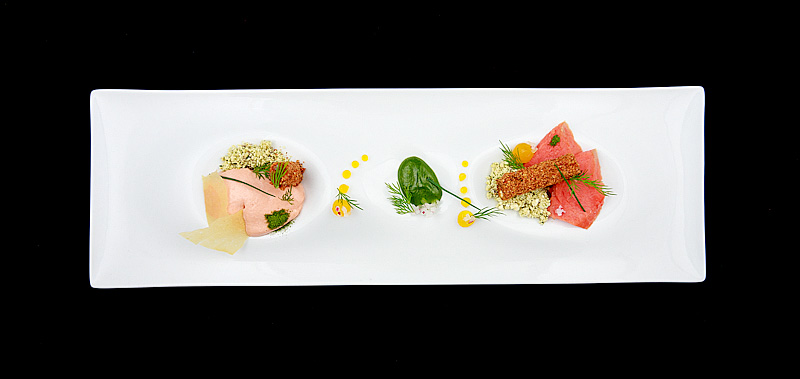
I’d like to think Steve would be proud at the lovely side of smoked salmon I ended up with; every time I make this I kick myself for not making it more often. It’s so flavorful and sweet and delicious I could eat it all day long. BUT NO! This time around, this filet would be separated and processed three ways. First, I froze a chunk of it and shaved it with a microplane into a fine ‘smoked salmon snow’, which was then dehydrated into a crispy powder. At the same time, I also dehydrated some slices of candied ginger, candied lemon zest, red bell pepper, and capers. These were all crushed together in a mortar and pestle to yield “Smoked salmon vegetable powder”.
While these were dehydrating, I also made a mayonnaise from egg yolk, lemon juice, some salt, and some fresh olive oil. I wrote a bit in my last post about tasting different olive oils; a few days after that experiment I was talking about this with Erik, who recently read the book on olive oil I keep mentioning (I swear I’m not shilling). He remembered that the book mentions an olive oil market in Berkeley that’s noted as a great resource for those wanting to learn more about this. So he and Vanessa and I went up to Amphora Nueva for a few hours of olive oil scrutiny. Amphora has dozens of fresh olive oils (one section featured olive oils pressed less than a week ago), and each stainless steel dispenser features extensive tasting notes. For as subtle as the differences in the Lorenzo oils were, the oils at Amphora were recognizably unique and vibrant. “The freshest ones will be more pepper-forward,” advised one of the ladies attending the shop, “while the ones that are a few months old will have mellowed, and will have more subtle, delicate notes you can get at.” There’s a section of Australian oils that are crisp and clean, there are robust Californian oils with grassy green apple and pepper notes, and a collection of Chilean oils that have vibrant tropical notes of banana and papaya. The oils are seasonal, rotate frequently, and you can buy empty bottles there and fill them yourself (the smallest size is $7, the largest is $12). I chose a bottle of the Chilean oil for the mayo I made here.
The olive oil mayo and vegetable/salmon powder are mixed to coat some salsify root. Salsify, exotic though it sounds, seems to be reasonably-consistent to find at Berkeley Bowl. For this recipe I peeled the salsify and packed them in butter and thyme, then cooked them en sous vide until they were nice and tender. Just before plating, the salsifies were warmed, rolled in the mayo, then dredged in the vegetable powder to yield a warm, buttery, yummy bite.
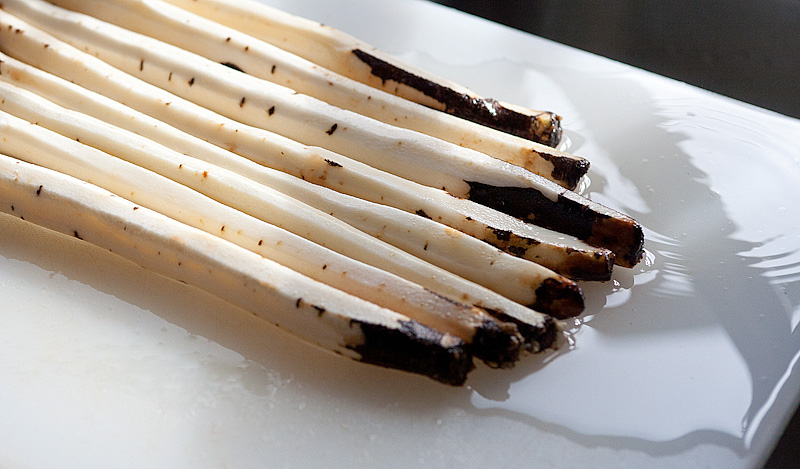
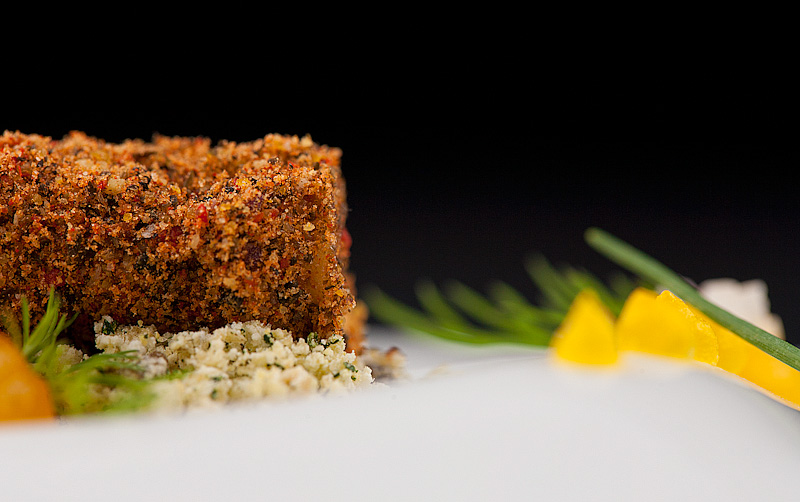
A second chunk of the smoked salmon was pureed with some water and olive oil, then mixed with whipped creme fraiche to yield light and fluffy Smoked Salmon Mousse. This is garnished with chips made from pureed garlic, chive tips, dill fronds, and Toasted Bread Crumb powder. The latter there involved baking some bread drizzled with olive oil, salt, and pepper at a very low temperature for about an hour until it was very dry and crouton-like, then crushing it with some dehydrated olives, parsley dust, and a powder made from olive oil and tapioca maltodextrin. A bite of the mousse and crumbs is straight-up bagels and lox, albeit impossibly refined and delicious. As I worked through the rest of the recipe, I kept stealing spoonful bites of the bread crumbs and the mousse, it was just so damn tasty.
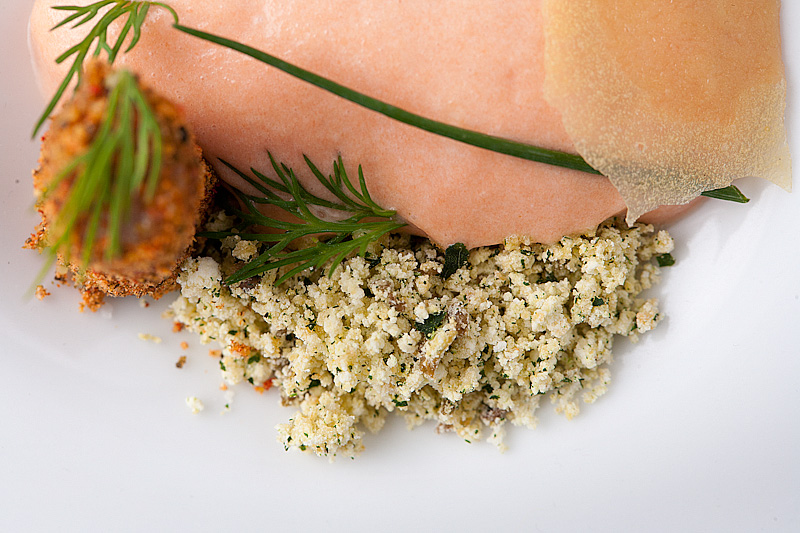
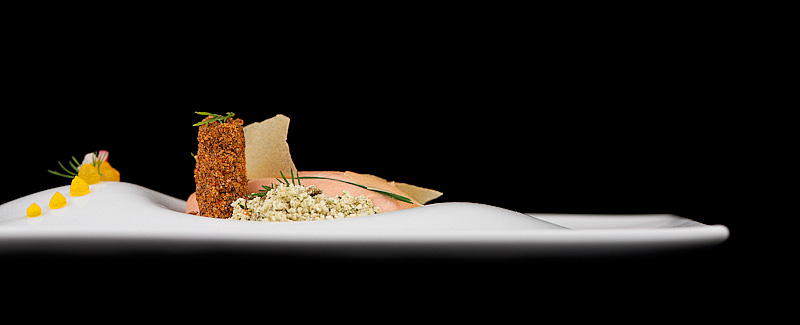
The third bit of salmon was cooked in olive oil until it was tender enough to flake apart easily. While this was cooking, I worked on making a Lemon Pudding from water, sugar, lemon zest and juice, agar agar, and some saffron for both color and flavor. Were it not for the saffron, the pudding turns our relatively colorless, but Alinea isn’t content to use only enough saffron for color. The recipe calls for a couple grams, which is enough to give the pudding considerable delicious saffron flavor. Saffron usually is packaged in 0.5g silly little boxes or tubes in most grocery stores I’ve found, but someone turned me onto this site that sells it in bulk for WAY cheaper. A 5g tin of it is pretty reasonably-priced and yields me enough to not be too bashful about using it liberally, which is awesome because the flavor of saffron is beautiful.
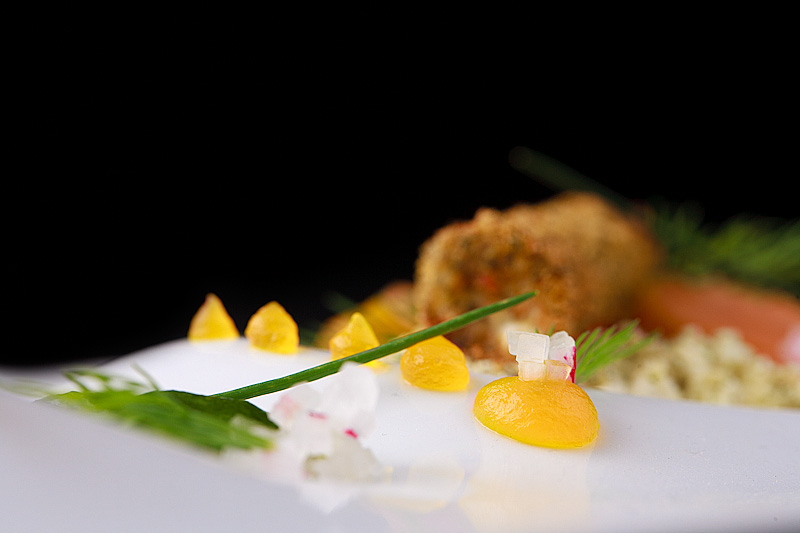
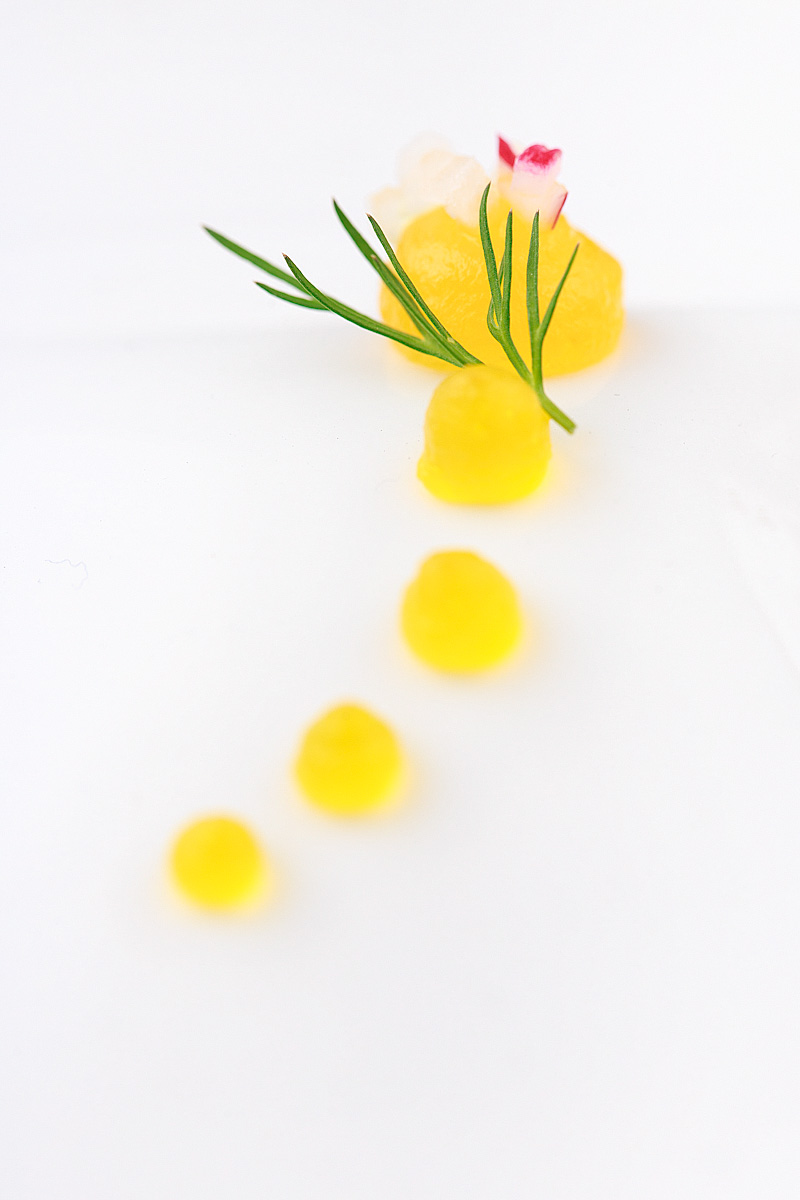
The final component here is a dill sauce, made using surprisingly-traditional methods. A roux is made from flour and butter; into this is mixed some cream and shallot and cooked until it thickens into a lovely sauce which is then transferred to a blender with a couple bunches’ worth of dill fronds and pureed into a beautiful deep green sauce. This is plated warm with some tiny radish dice.
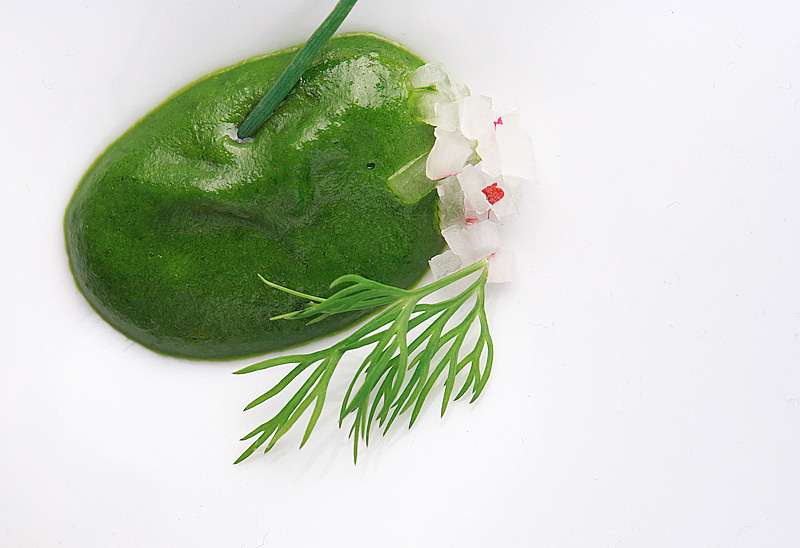
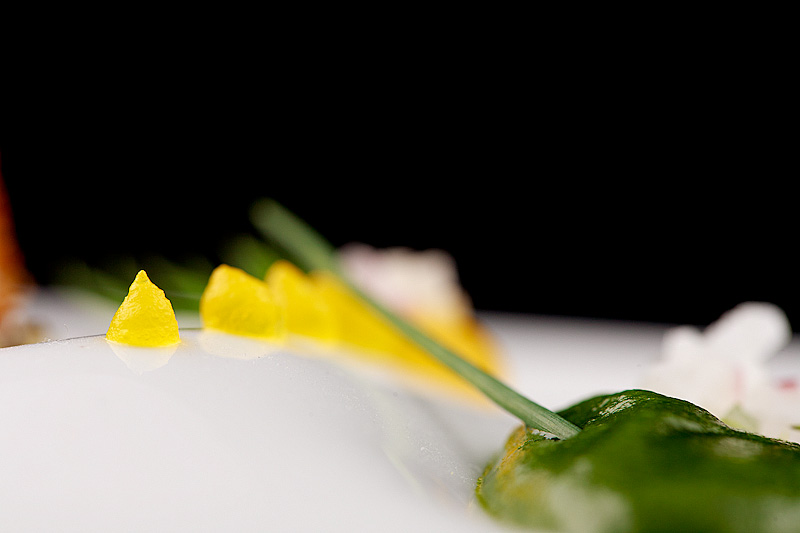
The flavors here are more or less unsurprising, but that’s exactly what makes this dish so comforting (and clearly everything is extremely refined and maximally-delicious). I think in the midst of a meal that involves no shortage of challenges, a respite of familiar, warm, comforting flavors is vital to re-center the palette. Sarah surprised me this weekend with a meal at Coi, which was beautiful but left me feeling a little off by the end (frustrating, given the exclusivity and cost) because the courses in their tasting menu seemed to get increasingly disorienting as the meal progressed, with fewer and fewer familiar or comforting flavors as we neared the end. It was the first time I’d felt so oddly exhausted at the end of what would have otherwise been a lovely menu, and in thinking about that I feel a part of it was due to this thing that Alinea understands…that sometimes it’s ok to pull things back to the realm of the comforting.
